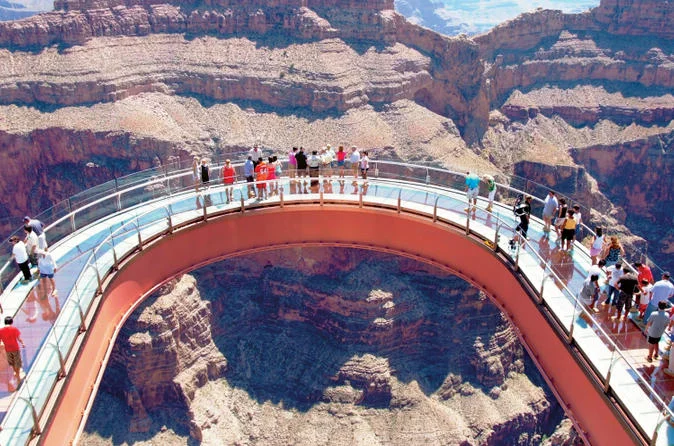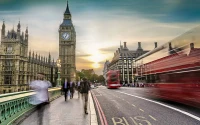So China just opened a bridge. And when I say "opened a bridge," I mean they sliced open the sky and stitched it back together with steel and concrete.
This thing, the Huajiang Grand Canyon Bridge, is an absolute monster. It’s now the world's highest, dangling 2,050 feet above a river. For perspective, that’s more than twice as high as the Royal Gorge Bridge in Colorado, which we Americans like to think of as a big deal. This new bridge is so high, planes probably have to ask it for permission to fly by.
It’s also the longest bridge of its kind in a mountainous region, stretching 4,600 feet across a canyon that used to take two hours to drive around. Now? Two minutes. Two hours of winding, treacherous roads reduced to the time it takes to listen to a pop song.
And offcourse, because this is 2025, it’s not just a bridge. It’s a tourist trap theme park hanging in the clouds. It has a high-speed glass elevator, a coffee shop, a bungee-jumping platform, and a glass walkway nearly 2,000 feet up. It’s the kind of insane, ambitious, look-what-we-can-do project that you’d see in a sci-fi movie. One of the project technicians, a guy named Tian Hongrui, told the state-run news he was “proud to have left a mark.”
Yeah, I bet he is. He helped build a monument. He left a mark you can see from space.
So, a Gun at School is "Minimal Disruption" Now?
And Then There’s the Other Canyon
The very next day, Monday, September 30th, halfway across the world in Avondale, Arizona, something happened at a different kind of canyon. Canyon Breeze Elementary.
There were no records broken. No tourists lining up.
A 14-year-old student was arrested. For having a handgun at school.
No threats were made, nobody was hurt. The staff, bless them, apparently followed their training, secured the weapon, and the police came and took the kid away. It was all handled. Cleanly. Efficiently.
The principal, Lori Pizzo, sent a letter home to parents. I’ve seen a million of these letters. They all use the same script, the same dead-eyed corporate language designed to neutralize panic. The letter said that school safety procedures “worked effectively” and allowed the school day to “continue with minimal disruption.”
Minimal disruption.
Let that phrase sink in for a second. A kid brings a weapon capable of ending multiple lives into a building full of children, and the official statement is that the day experienced "minimal disruption." It's the linguistic equivalent of putting a Disney-themed band-aid on a gaping chest wound. It’s not just a lie; it’s an insult to everyone’s intelligence. The goal isn't to inform, it's to manage the narrative. To make sure the gears of the system keep grinding without any inconvenient screaming or questioning.

They just want everyone to calm down and get back to work, get back to school, get back to pretending this is all fine and…
America's Great Infrastructure Project: The Strongly-Worded Email
The Normalization Machine
This isn't just sad. No, 'sad' doesn't cover it—this is a symptom of a terminal disease. The disease of normalization. We have perfected the art of dealing with the unthinkable. We have flowcharts for it. We have pre-written email templates.
The principal's letter went on to say the school was offering counseling and support to any students or parents who were concerned. Another line from the script. We don't solve the problem, but we'll sure as hell offer you a therapy session to help you cope with the consequences of us not solving the problem. It’s a closed loop of insanity.
I keep thinking about the two timelines. In Guizhou province, they spent three years and eight months building a bridge to conquer a physical grand canyon. They went from having around 2,900 bridges in the 1980s to over 32,000 now. They are physically, tangibly, undeniably connecting their world and overcoming obstacles with sheer force of will and engineering.
And what have we been doing for the last three years and eight months? For the last thirty years? We’ve been perfecting the lockdown drill. We’ve been teaching six-year-olds how to hide from a gunman. We’ve been drafting letters that use phrases like "minimal disruption" to describe events that should shatter the foundations of a community. We ain't building bridges to the future; we're building psychological bunkers and hoping the walls hold.
It’s like my last office job. We had this mandatory "active shooter" training video we had to watch every year. It was this horribly produced, low-budget film, and we'd all just sit there, dead-eyed, clicking through it to get our certificate of completion while making jokes about it in the company Slack channel. Because what else can you do? The absurdity is the only thing left to hang on to.
Then again, what are they supposed to do? Shut down every school in Arizona every time this happens? Maybe I'm the crazy one for even being angry about it anymore. The system is working exactly as designed. The disruption was minimal. The machine keeps running.
One country is building a 2,000-foot-high bridge with a coffee shop on it. The other is just trying to get through third period without a catastrophe. One technician is proud to have left a mark on the world. The other country has an entire generation of kids who are being marked in a very different way.
###
We Build Better Press Releases
###
When you get right down to it, the contrast is perfect. China had a problem—a giant, impassable canyon. So they built a world-record-breaking bridge over it. America has a problem—a giant, impassable canyon of violence and political paralysis. So we built a robust system of thoughts, prayers, and carefully worded emails to parents. Their infrastructure miracle is made of steel. Ours is made of jargon.
Reference article source:









